Introduction
Despite improvements in air quality since the 1950s, air pollution continues to affect our health.
In any urban environment, the five main sources of air pollution are:
- Road traffic emission from vehicle exhaust, tyre and brake wear
- Combustion energy plant emissions for example, gas boilers and diesel generators
- Burning of solid fuels for example wood, coal, charcoal etc from residential (open fire places, wood burners) and commercial premises (restaurants, commercial kitchens)
- Demolition and Construction sites produce Dust, and Particulate (PM10, PM2.5) emissions
- Non Road Mobile Machinery (NRMM) emissions which includes diggers, pumps and generators which are usually fitted with an diesel engine and not intended for transporting goods or passengers on roads
Further information regarding air quality in H&F and London can be found at Air Quality England, Mayor of London and Breathe London.
Air Quality Management Area
We have designated the borough an Air Quality Management Area (AQMA) as part of the national Air Quality Strategy.
View the air quality management order (jpg).
View the area covered on this air quality management area map (gif).
Air quality monitoring in H&F
There are currently two types of air quality monitoring networks that measure levels of the main health impacting Air Pollutants Nitrogen Dioxide (NO2) , Particulates (PM2.5, PM10) and Ozone (O3) across Hammersmith & Fulham.
The data from the council's six air quality monitoring stations is included in the council's Annual Air Quality Status Reports submitted to GLA and DEFRA. The reports also include background information on air pollution in H&F and details of our review and assessment of air quality.
Air quality annual status reports
We are aware that the 2023, 2022 and 2021 air quality annual status reports are not fully compliant with accessiblity regulations and some assistive technologies such as screen readers will not be able to fully access the information it contains. If you have any problems accessing the information in these reports, please contact us at airquality@lbhf.gov.uk
- 2023 Air Quality Annual Status Report (pdf 2.2MB)
- 2022 Air Quality Annual Status Report (pdf 1.83MB)
- 2021 Air Quality Annual Status Report (pdf 1.6MB)
- 2020 Air Quality Annual Status Report (pdf 2MB)
- 2019 Air Quality Annual Status Report (pdf 2.9MB)
- 2018 Air Quality Annual Status Report (pdf)
- 2017 Air Quality Annual Status Report (pdf)
- 2016 Air Quality Annual Status Report (pdf)
- 2015 Air Quality Updating and Screening Assessment (pdf)
- 2014 Air Quality Progress Report (pdf)
Air Quality Action Plan (2025-2030)
Hammersmith & Fulham is taking urgent action to Clean our Air. By working with residents, businesses and local partners, we are determined to improve our air quality, protect local nature and help local people live heathier lives.
After our consultation earlier this year the council has produced a new five-year Air Quality Action Plan (AQAP) for 2025-2030 that was adopted on the 16 December 2024. It lays out the steps we will take to:
- tackle air pollution from buildings and new developments
- reduce air pollution emissions from deliveries and transport
- monitor poor air quality
- protect public health and raise awareness of the issues around poor air quality
- protect residents, including those most at risk from poor air quality.
You can view the new action plan here.
Road traffic is the biggest source of air pollution in London
More than 1,000 people die each year in London due to poor air quality and several thousand others suffer serious health impacts such as breathing difficulties. It is also estimated that as many as a million people experience less serious effects.
You may think that you can't do much to help but if all drivers do a little bit to reduce pollution this will add up to a noticeable change - you can make a difference.
Think before you drive
Before you use your car ask yourself:
- do I really need to make this journey?
- could I combine several trips rather than making lots of short trips or share a car? Short journeys (less than 2 miles) when the engine is cold pollute up to 60 per cent more per mile than when the engine is hot.
- could I walk, cycle or take the bus or train instead of taking the car?
In Hammersmith & Fulham there are a quarter of a million car trips per week of less than 2 miles. That short journey might be ideal for walking or cycling.
Around 70 percent of the population are not active enough to stay fit. Thirty minutes of moderate activity 5 days per week is enough to cut the risk of heart disease and diabetes by 50 per cent and substantially reduce levels of blood pressure and stress. A simple way of doing this is to walk or cycle for short journeys.
Out of 10 car trips, could you make one by any other means?
If every driver did this it would cut traffic to the levels seen in the school holidays.
What can I do to help?
- Reducing the number of miles driven is by far the best way to reduce pollution.
- If every car in Hammersmith & Fulham were driven 5 miles less per week it would remove more than 10 million miles of traffic off H&F roads each year
- Switch off the engine when the car is stationary. Idling engines burn fuel and waste money. Sitting stationary is zero miles per gallon, switch off the engine whenever it is safe to do so
- Use air-conditioning (AC) sparingly. AC is a drain on the cars engine and can increase fuel consumption by up to 20 per cent. On not so hot days and in stop start traffic wind down the window or use the air vents instead.
- Check your tyre pressure. Under-inflated tyres will increase your fuel bills and increase emissions.
- Minimise drag. Roof or rear mounted racks, and driving with windows open increases wind resistance and the amount of fuel you use. So wind your window up and remove racks if you're not using them.
- Travel light. Extra weight increases the amount of fuel you use. Check the boot regularly and take out what you don't need.
Following this advice will help you do your bit to improve local air quality. It will also help reduce CO2 a greenhouse gas that contributes to global warming.
The car you drive
Vehicles with diesel engines are the largest source of air pollution in London. Petrol and diesel engines emit different levels of different pollutants. If you're buying a new (or second-hand) car you can help improve London's air quality by driving a less polluting vehicle. The Mayor of London Cleaner Vehicle Checker can help you make an informed choice when buying a new ULEZ-compliant car or van.
If you're buying a new or used ULEZ-compliant car, why not take a step further and find out how it performs in real-world driving conditions by visiting AIR Index.
Vehicles that have zero tailpipe emissions of air pollution are the best option. This includes electric vehicles and hydrogen fuel cell vehicles. Electric vehicles that could save you more than £500 per year on fuel costs as well as reducing pollution levels. There are a number of electric cars on the market with very low running costs. This kind of information can be found online on sites like Next Green car.
airTEXT - pollution alert service
The airTEXT website gives you free pollution forecasts for all London boroughs via text messages, voicemail and email. There are also smartphone apps with daily information on temperature, UV and pollen levels.
airTEXT alerts are particularly valuable if you suffer from asthma, emphysema, bronchitis, heart disease or angina or if you care for someone who could be at risk from high levels of pollution.
Sign up to the AirTEXT info service. Smart phone apps for the iPhone and Android hand sets are available for download.
Further advice when there is an alert for moderate to high or very high air pollution can be found at TfL Air Quality Advice and DEFRA Daily Air Quality Index
Engines off - no idling vehicles
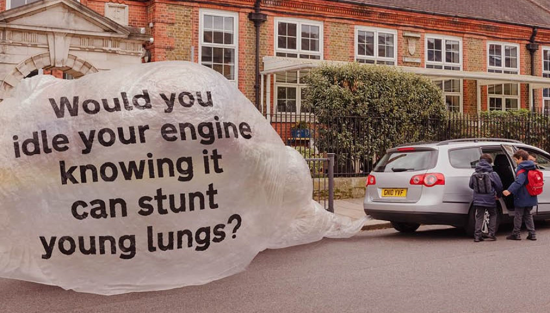
Idling (leaving your vehicle engine running while stationary) creates air pollution and is usually unnecessary. It is also an offence in law under the Section 42 of the Road Traffic Act 1988.
Hammersmith & Fulham Council is one of 31 London Local authorities who have joined forced to tackle engine idling as part of Idling Action London project, supported by the Mayor of London. For more information about the project see www.idlingaction.london.
As part of the project, Hammersmith & Fulham Council is offering its primary schools free opportunities to take part air pollution anti-idling workshops, and is offering free resources and toolkits to businesses and community groups wanted to help tackle this avoidable source of air pollution.
What can you do to help tackle engine idling? If you are a business, school or community group you can sign up to the Engines Off pledge! See www.idlingaction.london for more information.
Clean Air Villages (CAV) Supplier Directories
Improve air quality in your area by using our directory of businesses that offer ultra-low emission deliveries and services.
As part of the DEFRA-funded Clean Air Villages programme, H&F, Cross River Partnership and Mayor of London Air Quality Fund, are excited to launch the online Clean Air Village supplier directories for Fulham, Hammersmith and Shepherds Bush.
- Fulham Town Centre CAV Supplier Directory
- Hammersmith Town Centre CAV Supplier Directory
- Shepherds Bush Town Centre CAV Supplier Directory
These directories list businesses operating across the whole of the borough that include delivery using the council's Parcels Not Pollution emission free cargo bikes service, ultra-low emission electric vehicles or by foot.
It also supports the expansion of the Mayor of London's Ultra Low Emission Zone to include H&F from October 2021.
Ultra-low emission suppliers case studies
E-cargo bike for businesses
H&F Council is also supporting businesses with FREE advice and support in the form of one-off subsidies to help them switch to using cargo bikes, including electric ones, in their day-to-day business.
Parcels Not Pollution is available to any business, charity, market stallholder or organisation based in H&F.
Running until April 2025, businesses can now apply for up to either:
- £1,000 towards purchasing or leasing a cargo bike
- 50 per cent off the cost of using a cargo bike service in a two-month period (up to £300 per month).
Visit the Parcels Not Pollution webpage to apply.
H&F shared electric van services
We've teamed up with Zipcar, Fulham Broadway BID, W12 LandSec, and the Park Royal Business Group (PRBG) to launch the first shared electric van service for small and medium businesses in Hammersmith & Fulham.
With 4 vehicles available for use across the borough, jump into one of the electric vans and help reduce traffic, congestion and air pollution levels in H&F.
River freight
For businesses considering using the river for freight into Hammersmith & Fulham, CRP have launched the Thames River Freight Directory as part of the DEFRA funded Clean Air Logistic for London (CALL) project. This interactive web tool provides information about utilising The River Thames for freight. Businesses can use the map to view information about London's river infrastructure (piers and wharfs), whilst the Directory provides details on 2 vessel operators and ultra-low emission (cargo bikes and electric vehicles) last mile couriers, which can help to deliver river freight operations.
Building emissions
After road transport, buildings are the second largest source of air pollution in London, emitting 44% of the total Nitrogen Oxides in London, or about 2,950t/yr. A typical domestic gas boiler in a day produces nitrogen dioxide pollution equivalent to driving a new Euro 6 diesel car for 70 km (the distance from Hammersmith to Haywards Heath, West Sussex). Buildings are also the second largest anthropogenic source of particulates after road transport, contributing 18% of London emissions through gas heating, large boilers, and industrial plant. Building emissions arise primarily from combustion to provide space and water heating and some industrial processes. Domestic sources, primarily water heating gas boiler exhausts, are distributed over wide areas, diluting their pollution.
While commercial heating plant emissions can be intense, these are required to have tall chimneys and special abatement equipment, to minimise concentrations downwind and the chances of a plume reaching the ground. Thus, buildings do not tend to create pollution exceedance hotspots, but contribute substantially to the urban background pollution concentrations.
To reduce the impact of building emissions on local air quality and on the climate it is encouraged that building use higher thermal efficiency fabric standards such as Passivhaus, WELL Building Standards, Association of Environment Conscious Building and the 'Low Energy Building Design' concept that only use non-combustion renewable energy technologies
Non-combustion based energy technologies should be prioritised over Combustion based energy plant e.g. Combined Heat and Energy Plant, Gas boilers to avoid adverse impacts on Local Air Quality and the Climate.
Buildings can reduce their Nitrogen Oxide (NOx), Ultra fine Particulates (PM2.5, PM10) and Carbon CO2 emissions by using a combination of non-combustion air quality neutral technologies such as Air Source Heat Pumps (ASHP) Guide to air source heat pumps - Energy Saving Trust, Ground Source Heat Pumps (GHSP), electric boilers, and Solar Photovoltaic panels (PV).
Indoor air quality and gas cooking
Cooking with gas releases hazardous air pollutants into our homes. Over 36 million people in the UK cook with gas appliances. They may be exposed to levels of indoor air pollution that would exceed UK outdoor air quality standards. When in use, gas hobs and ovens emit carbon monoxide (CO), nitrogen dioxide (NO₂), Benzene and carbon dioxide (CO₂) which can linger indoors after use. Research indicates an association between NO₂ exposure and the development of asthma in children. Gas cooking appliances also leak unburned methane, a potent greenhouse gas.
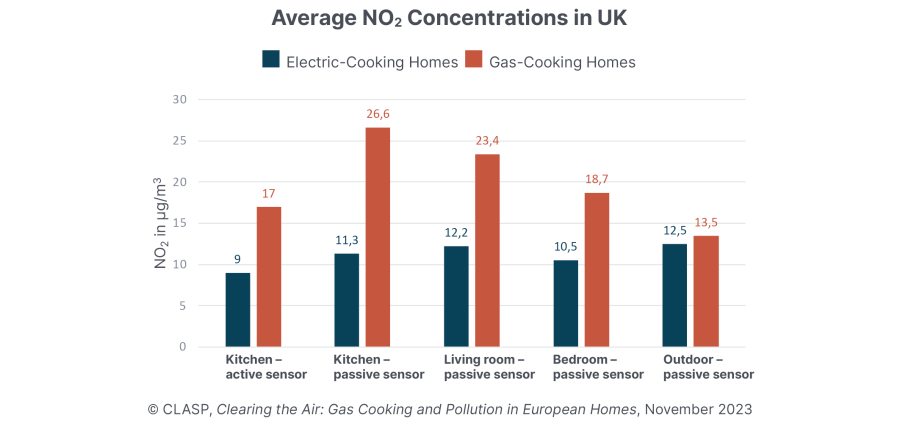
Using a single gas hob on for 45 minutes raised benzene levels to above that found in second-hand tobacco smoking, or at the boundary of oil and gas plants, with emissions 10 to 25 times higher than that from electric coil hobs a Gas Combustion from Stoves emits Benzene and Increases Indoor Air Pollution study has found. Benzene produced by gas stoves also migrated throughout homes, in some cases elevating bedroom benzene concentrations above WHO health benchmarks even after the stove was turned off. Induction hobs emit no benzene at all.
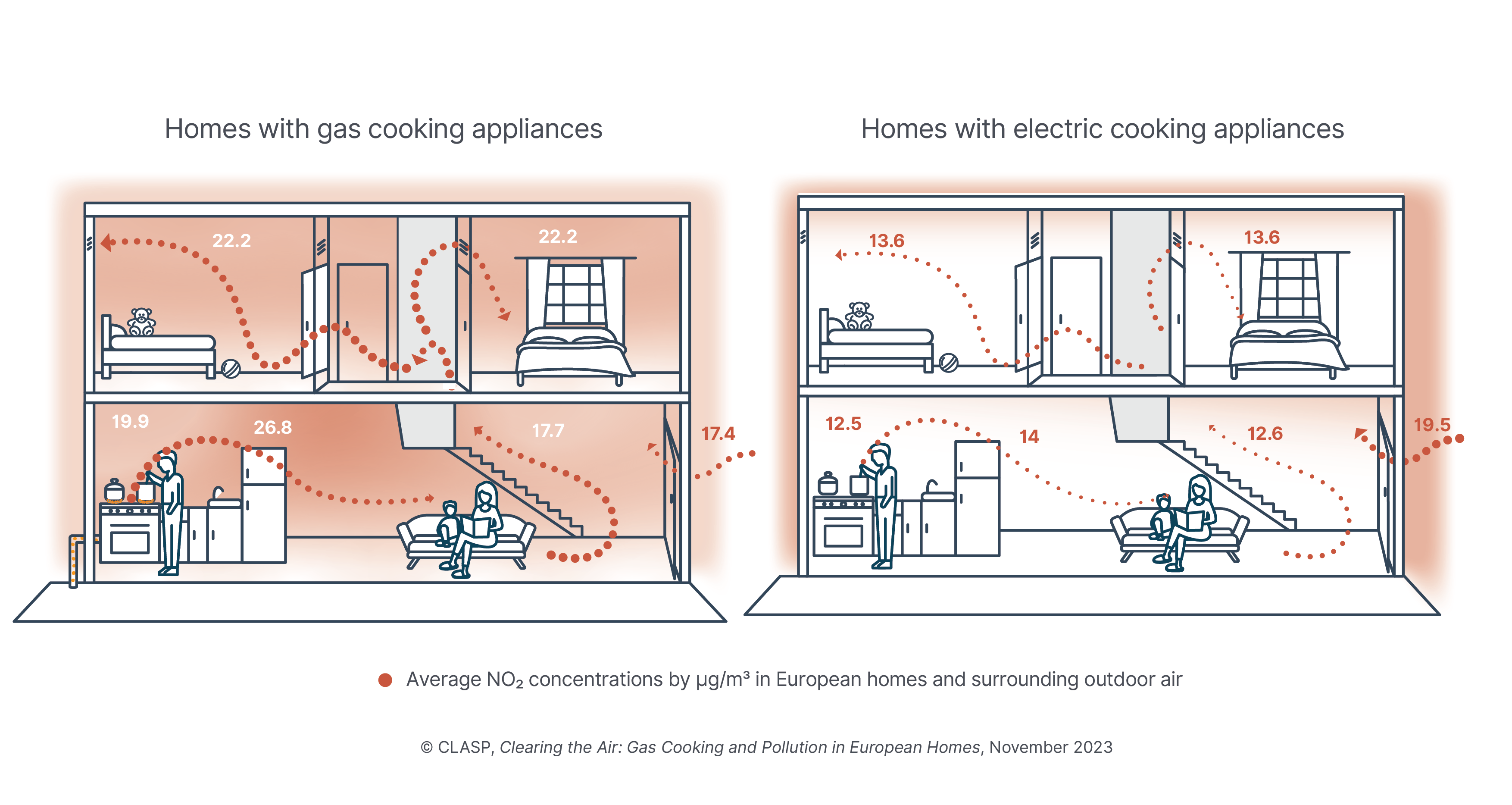
Health impacts of pollutant exposure
Adults
Nervous system
- Impacts on the central nervous system (CO, PM)
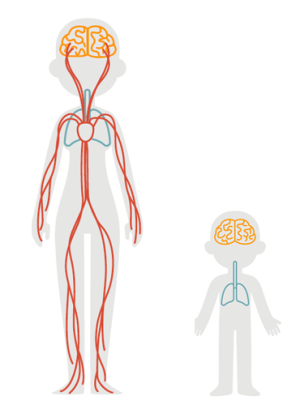
Respiratory system
- Pulmonary function/breathing problems (PM, NO2)
- Irritation of the eyes, nose and throat
- Irritation, inflamation and infections
- Asthma and reduced lung function (NO2)
- Chronic obstructive pulmonary disease (PM)
- Cancer (PM)
Circulatory system
- Cardiovascular diseases (PM, NO2)
- Impacts on liver, spleen and blood (NO2)
- Blood pressure (NO2).
Children
Nervous system
- IQ, learning deficits, psychiatric problems in the transition to adulthood (CO, PM, NO2)
Respiratory system
- Irritated airways and aggravated respiratory symptoms such as wheeze, cough, chest tightness, difficulty breathing (PM, NO2)
- Asthma and reduced lung function and increased susceptibility to lung infection (NO2)
- Changed lung function
What can I do to reduce indoor air pollution in my home?
- Minimise exposure to gas cooking emissions: Minimise gas cooking use by using plug-in appliances, such as electric kettles, fryers, or induction hobs.
- Improve ventilation if gas cooking is the only option: Use cooker hoods while cooking and for at least 10 minutes after. Clean grease filters regularly to ensure the exhaust capacity is not blocked by grease and grime. Use back burners that are closest to the cooker hood. Ideally, cooker hoods should vent outdoors so fumes are directed out of the kitchen. Open windows if outdoor air pollution is low, or you live in a low-traffic area.
- Install and maintain carbon monoxide detectors: Install detectors in kitchens and near bedrooms. Use devices that detect low levels. Get a Gas Safety inspection conducted annually. If carbon monoxide is detected, open all windows and doors, turn off your gas cooking appliances and leave the house. If you suspect you have carbon monoxide poisoning, see a health professional to take a blood or breath test. Call for a gas safety inspection, by a Gas Safety-registered engineer.
- Replace the gas cooker: Replace gas cooking technologies with energy-efficient electric alternatives, whenever possible.
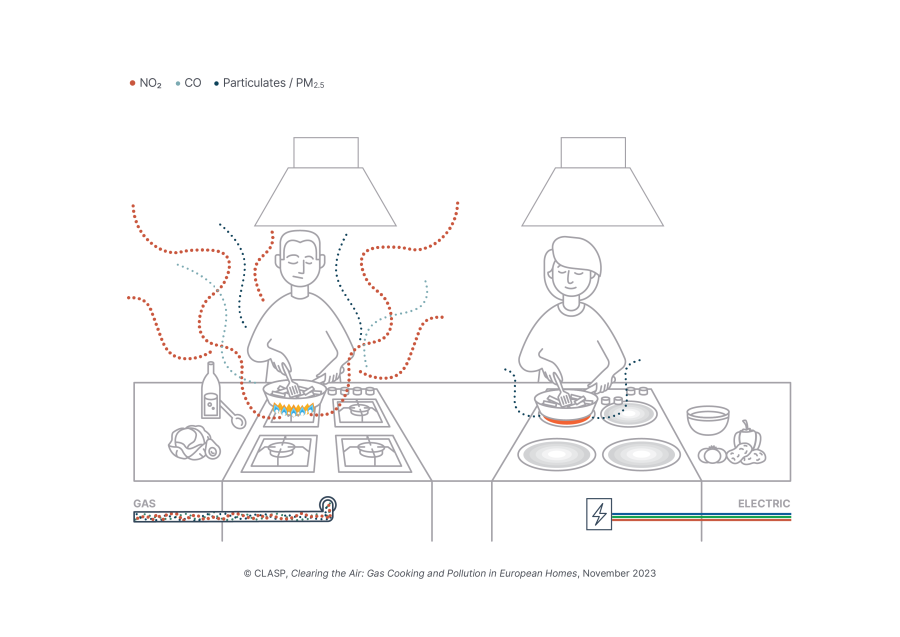
For more information on actions individuals can take, see How to improve air quality in your home when you have a gas hob or oven
Smoke control area
Hammersmith and Fulham is a smoke control area which means that it is an offence to emit smoke from:
- a chimney of a building
- moored vessels such as canal boats
- a furnace or any fixed boiler.
Smoke control areas are only used to enforce emissions of smoke from chimneys, not from fires outside in the open for example smoke from bonfires, barbecues, garden waste incinerators and chiminea.
Visit GOV.UK for more information on smoke control area rules.
The Healthy Waterways London project

Healthy Waterways, London project is being undertaken by Hammersmith & Fulham in partnership with other London boroughs, Port of London Authority and the Canal and River Trust. It is funded by the Mayor of London's Air Quality Fund.
The project aims to establish a strong and positive relationship with boating communities and to design a Healthy Waterways Strategy to set out a future vision and opportunities for cleaner air, for the benefit of everyone who lives, works, learns and travels on and alongside London's canals and inland waterways. Further information can be found on the Healthy Waterways, London website.
Have your say on cleaner, healthier waterways!
RRR Consultancy Ltd is researching air pollution, fuel use, and energy options among London boat dwellers to inform policy and support cleaner energy choices.
Boaters are invited to participate in a survey or interviews to help shape a more sustainable waterways strategy:
They will be offering a prize draw for all those who complete the survey with a first prize of a £100 voucher, and second and third prizes of £75 and £50 vouchers.
Smoke control order
Between Wednesday 13 December 2023 and Wednesday 7 February 2024, we consulted on a new, borough-wide smoke control order that included moored vessels on waterways.
The London Borough of Hammersmith & Fulham Smoke Control Order 2024 came into operation on 7 October 2024.
The amendments made to the Clean Air Act 1993 by the Environment Act 2021 include:
- enabling local authorities to impose financial penalties for emissions of smoke in a smoke control area, removing this as a criminal offence
- introducing offences relating to the sale and acquisition of solid fuel in England
- enabling local authorities to apply smoke control orders to vessels (such as houseboats).
In a smoke control area, you can only burn fuel from the list of authorised fuels, unless you're using a DEFRA approved exempt appliance. You must only use the types of fuel that the manufacturer says you can use in the appliance.
If you do not follow the rules in a smoke control area you may:
- have to pay a financial penalty of £175 up to £300, if visible smoke is seen being emitted from your chimney (section 19A of the Clean Air Act 1993)
- be fined up to £1,000 by a magistrates' court if you acquire or sell controlled solid fuels (section 19B of the Clean Air Act 1993).
Where a council officer witnesses an offence, we can undertake enforcement in accordance with our enforcement policy.
For a first offence, we will issue a warning. The warning provides an opportunity for the responsible person to address the problem.
A second offence carries a financial penalty of £175, while subsequent offences carry a financial penalty of £300.
A person issued with a financial penalty has a right of appeal through the First-tier Tribunal (General Regulatory Chamber).
The main pollutant emitted by burning solid fuels like wood is ultra-fine particulate matter, also known as PM2.5. It's not visible to the naked eye, so even the use of 'smokeless' fuels causes air pollution.
PM2.5 is widely acknowledged as being the air pollutant which has the greatest impact on human health. Both short and long-term exposure to PM2.5 increase the risk of early deaths from respiratory and cardiovascular diseases as well as increased hospital admissions.
View more information in our leaflet:
London Wood Burning Project

Hammersmith & Fulham Council is a member of the DEFRA funded London Wood Burning Project.
The project commenced in late 2022 with fifteen member boroughs and includes a survey of the wood burning habits, and awareness of the health impacts, across the project member boroughs.
Visit the London Wood Burning Project website for more information about the project.
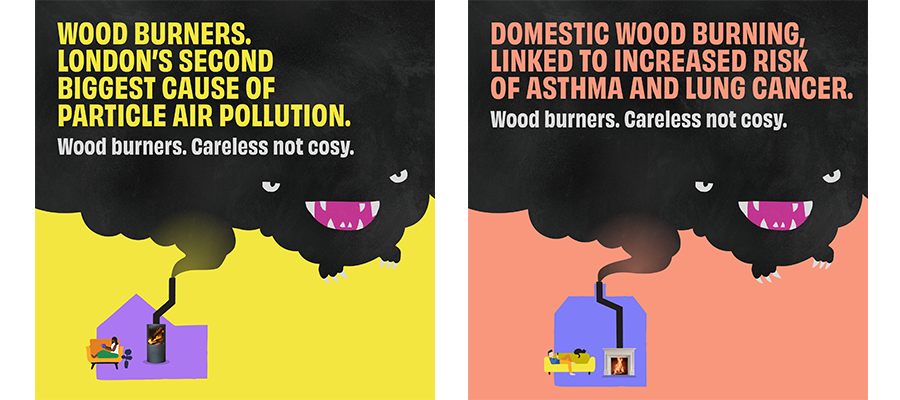
PM2.5 emissions
Children growing up exposed to PM2.5 are more likely to have reduced lung function and can develop asthma. Current evidence suggests there is no safe level of PM2.5.
- Open fireplaces are the most polluting way to burn solid fuels
- During the 22nd and 23rd of January 2023 air pollution in London reached the top value of 10 on the UK government's index. This was London's worst air pollution since January 2017. Home wood burning played a large role in these pollution peaks in London according to data from Imperial College London, especially during the evenings. Analysis of particulate data (PM10, PM2.5) showed that between 60% and 70% came from wood or solid fuel heating.
- DEFRA approved exempt appliances and authorised fuels still produce significant air pollution within homes, and have a negative impact on local external air quality and public health of the wider community
- Solid fuel burning emits harmful particle pollution – a mix of PM10 and PM2.5 into the air we breathe that is linked to lung disease, heart disease, dementia and strokes
- 17 % per cent of particulate matter (PM) pollution in London can be attributed to domestic wood burning. This compares with road transport (12%). See Airborne particles from wood burning in UK cities KLC - (pdf)
- All types of solid fuel heating will produce 450 times more particulate matter (PM2.5) pollution than using gas
The hourly PM2.5 emissions from 1 eco-certified wood burning stove (3.1 gms per hour) is equal to 18 newer diesel passenger cars (each rated at 0.17 gms per hour) or 6 modern heavy goods vehicles (each rated at 0.5 gms per hour). Data from "Potential Air Quality Impacts from Biomass Combustion", Air Quality Expert Group (UK), 2017.
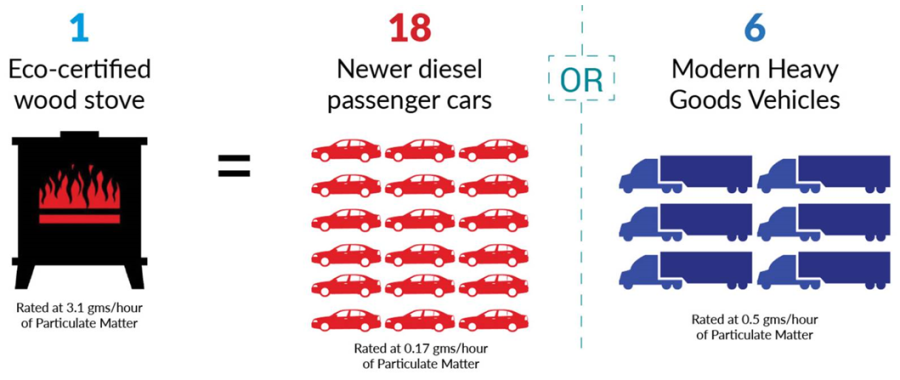
| Appliance | Main Fuel Source | Local PM2.5 Emissions (g/MWh) | Pollution Rating |
|---|---|---|---|
| Air/Water Source Heat Pump | Renewable Heat from Air/Ground/Water | 0 | Low |
| Electric boiler | Electricity | 0 | Low |
| Gas Fired Boiler | Gas | 0.72 | Moderate |
| Oil Fire Gas Boiler | Oil | 16 | Moderate |
| Pellet Fired Boiler | Wood | 216 | High |
| ClearSkies Stove-Level 5 | Wood | 235 | High |
| Clearskies Stove Level 4 | Wood | 285 | High |
| DEFRA Ecodesign Stove | Wood | 335 | High |
| Non DEFRA exempt Stove | Coal, Wood | 2660 | Very High |
| Solid Fuel Open Fire | Coal, Wood | 2950 | Very High |

Choosing the right fuel
Choosing what you burn and how you burn it can make a big difference to the pollution it creates. Reducing the personal pollution, you and your household are exposed to from domestic burning, is crucial to maintaining long term health and reducing the risk of respiratory and cardiovascular diseases.
Usually wood that has been kiln dried or seasoned to have a lower moisture content will be much less polluting, as much as 50 per cent less pollution than emitted from burning fresh logs. Drier wood is also more efficient, producing more heat per log and less likely to cause a chimney fire. Wood that has the Woodsure Ready to Burn label is certified to have a low moisture content, for a full list of suppliers see the list on the Woodsure website.
You should not burn old pallets, furniture or scrap wood as it may contain contaminants that can be harmful to your health and the environment.
It is important to store your fuels correctly to make sure your wood and briquettes do not get damp from the rain or damp in the ground.
Any stove or fireplace should also be properly maintained and your chimney should be swept regularly.
As a minimum, you should make sure that your stove meets the legal requirements. From January 2022 all new woodburning stoves will have to meet new EcoDesign standardsIf you're on a low income and burning solid fuel is your primary source of heating, you may be eligible for free heating, insulation and ventilation improvements under the Mayor's Warmer Homes Programme.
Bonfires and burning
There are no laws against having a bonfire, but there are laws against the nuisance they cause. Burning materials can be very harmful to the environment and peoples' health. That's why we discourage residents and businesses from burning in our borough.
For more information visit the bonfires and burning page.
Contact us about air quality
Complaints of smoke or fumes from the burning of solid fuels (wood, smoke fuels, coal) coming from the chimneys of domestic or commercial premises and flues of commercial premises should be reported to the environmental protection team.
To comment on these pages, or to find out more about air quality issues, email us at airquality@lbhf.gov.uk